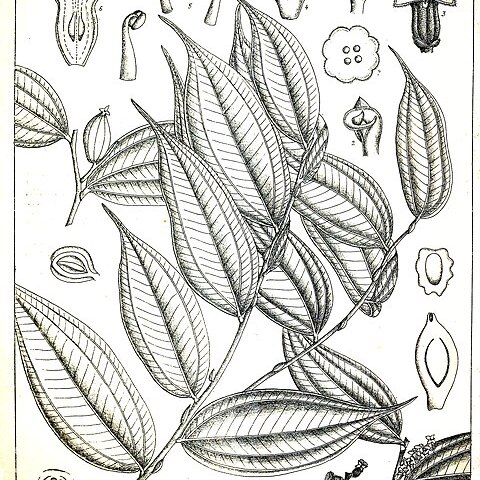Trees, shrubs and subshrubs; individuals bearing leaves of more than one distinct size but not (in our area) very unlike in shape. Leaves of the larger sort alternate, shortly petiolate, entire, exstipulate, usually ± elliptic, usually glabrous at maturity, usually with 2–6 lateral nerves curving up from near the base to become subparallel. Flowers small, numerous, in spikes. Calyx-lobes (? 3–) 4–5, ± triangular-deltoid, ± erect. Petals 4–5. Stamens twice as many as the calyx-lobes; anthers didymous. Ovary inferior; styles 4–5 (–8), ± thickened below; ovules solitary in each cell. Fruit a ± oblong drupe. Endosperm absent.. The species known from our area also have the following characters in common:Leaves usually narrowly to broadly elliptic or lanceolate, more rarely ovate or rotund. Calyx-lobes 4 (–7), glabrous within. Petals 4 (–6), divided above. Stamens 8 (–12), with ± raised ± convoluted or muricate glands between their bases. Styles 4 (–5).
Leaves alternate, shortly petiolate, exstipulate, often with alternating reduced stipuliform leaves; leaf-lamina usually ± elliptic, entire, often inequilateral, with 2–6 lateral nerves curving up from near the base and soon becoming subparallel, leathery to papery, mostly ± glabrous with age.
Stamens twice as many as the petals, inserted at the mouth of the calyx-tube or sometimes the epipetalous ones adnate to the basal parts of the petals; filaments short, usually unequal in length, subulate or narrowly linear; anthers small, ellipsoid or ovoid, didymous.
Inflorescences many-flowered, spike-like, racemose or paniculate, axillary or supra-axillary, solitary or serial, ± slender, ebracteate or with minute, brownish, pubescent, soon caducous bracts.
Seed with a leathery testa; albumen thick and hard; embryo linear or slightly fusiform, longitudinally embedded in the seed; cotyledons minute or absent; endosperm absent.
Ovary inferior, (3)4(8)-locular, each locule 1-ovulate; styles (3)4(8), short, subulate, ± thickened below, erect or recurved, ± free, arising from the epigynous disk.
Petals scarcely longer than the calyx-lobes, lobed or laciniate (rarely entire), involute, inserted at the mouth of the calyx-tube.
Calyx pilose; calyx-tube campanulate, adnate to the ovary; calyx-lobes (3)4–5(7), ± deltate, acute at the apex, ± erect.
Undershrubs, shrubs or trees, usually glabrous, with young shoots often pubescent or pilose, without aerial roots.
Fruit an ellipsoid to pyriform drupe, smooth or ridged, usually 1-locular and 1-seeded.
Flowers small, unisexual, polygamous or more usually bisexual, sessile.
Disk obscure, crenulate or lobed.

